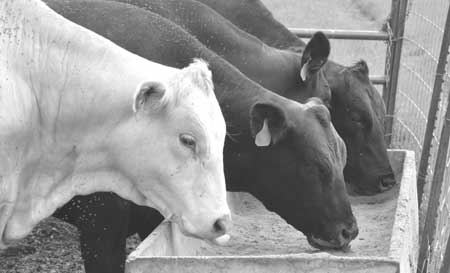|
Stocker Gains More Than 2.5 Pounds Per Head Per Day Realized
OVERTON, TEXAS
As cattle prices continue to soar, breaking all previous records, some might wonder why anyone would take animals off winter pasture at 800 to 850 pounds in mid to late May, and continue them on pasture instead of moving them directly into a feedlot or to the sale barn.
The answer to the ‘why’ retain ownership was to study beef cattle stocking opportunities and management strategies that commercial operations cannot afford to try, said Dr. Monte Rouquette, Texas A&M AgriLife Research scientist, Overton.
And the results of this first year of the two-year study were impressive, Rouquette said. At the higher supplementation rate, cattle gained an average of 2.53 pounds per head per day.
What Rouquette found really exciting, he said, was that with the higher supplementation rate and the quality of this summer’s forages, he could have easily doubled the stocking rate and realized more than 2,000 pounds of gain per acre over the 110-day study.
“That’s what we’d expected, and that’s what, as it works out, we would have gotten,” he said.
Instead of moving cattle from winter pastures directly into the feedyard, Rouquette split the cattle in several groups. All groups were put on Tifton 85 Bermuda grass pastures. Some were allowed to graze only, while three groups were supplemented with three different levels of dried distillers’ grain.
In this kind of study, each supplementation rate – or no supplementation – is called a “treatment,” he said. Each treatment – or group – was replicated four times on separate pastures, with five to six head per treatment, or nearly 100 head for the entire study.
“The primary objective of forage/animal research is to evaluate seasonal as well as year-long stocking opportunities,” he said.
In the study, “The 2014-2015 Dried Distillers’ Grains and Beef Competitiveness Research Initiative,” the supplemented cattle were given three different daily rations of dried distiller’s grain and allowed to graze ad libitum – all they wanted – on Tifton 85.
Tifton 85 is a hybrid Bermuda grass cross released in 1992 by the U.S. Department of Agriculture Research Station at Tifton, Georgia. It was developed by Dr. Glenn Burton, who also released coastal Bermuda grass in 1943. Rouquette used Tifton 85 in the study because it is one of the most nutritional and productive warm-season grasses available, he said.
This year, Rouquette found it was possible to produce gains of 1,500 to 1,600 pounds per acre with stocking rates of four to five animals per acre at the higher supplementation rate on Tifton 85 pastures at the Texas A&M AgriLife Research and Extension Center at Overton. Gains varied, as would be expected, depending upon the supplementation rate.
The supplementation rates were a quarter of 1 percent body weight per head per day; a half of 1 percent body weight per head per day; and 1 percent body weight per head per day, Rouquette said.
Even those cattle that received no supplementation did very well, he said, gaining about 1.53 pounds per head per day.
“That is within reason of what we would expect a stocker calf of that age and that size to gain,” Rouquette said.
At the one-quarter of 1 percent body weight supplementation rate as well as the one-half of 1 percent body weight rate, cattle gained about 2.22 pounds per day.

At the higher supplementation rate
of dried distillers’ grain, cattle gained
an average of 2.53 pounds per head
per day on Tifton 85 pastures.
Texas A&M AgriLife Communications photo by Robert Burns
“Or they increased almost 0.7 pound per day over non-supplemented, pasture only cattle – what we might expect from previous experimentation,” he said. “This shows that a quarter of 1 percent per day had an ‘additive effect,’ meaning we are enhancing gain with only a small amount of supplement, which is quite acceptable.”
An ‘additive effect’ is an animal science research term for when cattle eat the same amount of forage; not replacing part of their grazing with the dried distillers’ grain, Rouquette explained. Whether supplementation is adding to or replacing forage grazing is easy to determine because it’s known most stocker beef cattle can usually only consume about 2.3 to 2.6 percent dry matter of their body weight a day, depending upon the breed and the type of pasture.
He emphasized there was no difference between the half of 1 percent of body weight supplementation rate and the quarter of 1 percent supplementation rate.
At the full 1 percent of dried distiller’s grain per body weight, average daily gains jumped to about 2.53 pounds per day, he said.
By late September, the calves weighed about 1,100 pounds, and were certainly ready for the feedlot, Rouquette said.
“Or, as an alternative, they’re ready for a forage-finished or grass-fed niche marketing program, if that is the choice,” he said.
Rouquette also noted that the higher gains with 1 percent supplementation rate showed there was a substitution effect, not an additive effect. That is, the cattle were substituting part of the dried distiller’s grain for the forage they would normally eat.
“This means the stocking rate on these pastures, this year, could be substantially higher on the 1 percent group,” he said. “Stocking rates, of course, are zip code specific. This year, four to five animals per acre was not an extreme stocking rate for this location.”
Rouquette said in a commercial setting, another two or three head per acre could have been added on these pastures, this summer.
“The temperature conditions during this summer allowed for some very acceptable average daily gains,” he said. “In another year and with higher temperatures, animal behavior for grazing and nutritive value of forages may be negatively impacted, and daily gains would likely suffer.” ∆
|
|